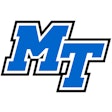Athletic departments are rethinking ways to make their travel dollars go farther.

If our current economy is headed for the brink, it's a return trip of sorts for Perrin. He, like college athletics administrators across the country, has been forced to rethink how teams travel within budget when faced with the rising cost of fuel, airfare and accommodations.

250+ Exhibitors & 190 Educational Sessions | abshow.com.
"When I came here, we were staying four, five, sometimes six kids to a room, and bringing in rollaway beds," says Perrin, who serves as associate to the UA athletic director. "We haven't reached that level yet, but it's a difficult time for everybody - no doubt about it - and it could get worse before it gets better. We just all have to be cognizant of that and do everything we can to rein in our expenses."
In relatively remote Tucson, travel consumes 10 percent of Arizona's $42 million athletics budget. Whereas travel budgets for individual teams have typically increased 3 to 5 percent annually to keep pace with inflation, this year 12 of 18 Wildcat teams saw their travel budgets jump 5 percent or more. Among the half dozen in a holding pattern are football and men's basketball. But even those big-revenue sports have required some creative bookkeeping. "Our budgets for football and basketball are very large to start with, and so we were able to shift some stuff around from other operational areas to cover travel cost increases," Perrin explains. "For example, we didn't feel like we had to fulfill all the equipment needs we had forecasted for this year. So we were able to move some money, a line item in the equipment budget, over into travel."
Schools everywhere are sacrificing. The University of Wyoming women's soccer team, which had been allotted $30,000 toward one charter flight this season, couldn't reconcile that figure (which had been adequate for past trips) with a 2008 charter quote of $50,000. Instead, the team took the two-hour bus trip to Denver International Airport and flew economy class to an August match against Western Michigan University in Kalamazoo. But even flying commercial has gotten more costly for Wyoming athletics, which had benefited from a group travel arrangement with Frontier Airlines (saving the department some $200 per ticket) until the carrier filed for bankruptcy in April.
Teams booking commercial flights are also discovering that student-athletes who check second and third bags can add more than $100 per individual to road trip expenses. Administrators at Division III Rhodes College prohibited football players from checking luggage when the team flew last month from Memphis to San Antonio to play Trinity University. The bags were shipped via rental truck with the rest of the team's equipment, saving an estimated $2,100. "That's a set of volleyball uniforms," Rhodes athletic director Mike Clary told the Memphis Commercial Appeal.
Ohio State University chartered two planes to carry its football entourage to Los Angeles for a September game against USC, paying a fuel surcharge of $24,200 - 10 times the amount paid in the past. Despite its annual athletic department budget of $115 million, Ohio State isn't above reviewing every possible cost-saving measure, according to Jen Bolla, who helps coordinate travel arrangements for all 35 Buckeye teams. "There may be some sports that look at not taking as many utility players, those extra two or three people that budgets may have allowed for last year," she says.
Teams are looking at building away schedules that cover fewer miles, too. "If there is a tournament in Los Angeles that is of the same caliber as a tournament in Indianapolis, does it make sense to go all the way to the West Coast?" Bolla asks. "It's not necessarily eliminating the date on the schedule, but rethinking the destination."
At the Big 12 Conference meetings in May, the prospect of league football rivals facing each other in lieu of far-flung non-conference opponents was broached, as was the idea of replacing two non-conference basketball games with additional Big 12 games. Kansas State University deputy athletic director Jim Epps, for one, thinks such changes may be imminent, in part because travel costs have inflated the going rate of non-conference games that guarantee payouts to the visitors. "Particularly in the sport of football, buy games have just gone through the roof. Texas paid an opponent [Florida Atlantic] $900,000" this year, Epps notes. "But scheduling inflation is also on the rise in basketball, where schools are demanding $60,000, $70,000, $80,000. It wasn't that many years ago that we were paying them $15,000 to $20,000."
Even the NCAA has tightened its belt by expanding the radius - from 350 to 400 miles - in which participating teams (with the exception of Division I basketball teams) are expected to travel by bus to the association's 212 championship events. In addition, teams are expected to travel up to 150 miles (up from 120) to an airport offering the least-expensive bookings. Combined, these changes are expected to trim by $500,000 the NCAA's annual member travel reimbursements, which have risen 53 percent from three years ago to $42.6 million. Men's basketball hasn't escaped scrutiny entirely, as the NCAA is considering using software already available to factor travel distance into tournament bracketing. Moreover, the association may save an additional $1.5 million per year by limiting baggage reimbursements, and shipping equipment by truck or air freight could save $10,000 per trip, according to an NCAA memo sent to member institutions Sept. 23.
As for the ultimate impact of the economic downturn, NCAA president Miles Brand told Bloomberg's Curtis Eichelberger last month, "We have no idea how bad it will be."
Dealing with economic uncertainty will remain "one of the great challenges in front of athletic departments for the foreseeable future," insists Mike Broeker, deputy athletic director at Marquette University, whose teams have long made a practice of busing from Milwaukee to Chicago's O'Hare International Airport for less costly and often more convenient flights.
"Thankfully, we have coaches who are pretty proactive when it comes to travel, thinking ahead and understanding our fiduciary responsibility to the university," says Broeker, adding that Marquette, a private institution, has budgeted for a 10 to 12 percent increase in travel expenses this year. "Usually, fall sports schedules are done in the early spring, so it gives coaches an opportunity to look pretty far in advance at flights and other options, such as combining trips. If you're playing Rutgers and Villanova on the same weekend, and you know it enough in advance, it might be easier to go from Chicago to Philly and then bus up to Newark and fly back from there. It's working creatively with our business staff and our travel agents to build the most fiscally responsible travel itinerary."
The last thing Broeker wants to see is Marquette coaches and student-athletes put at a competitive disadvantage on the field and in the classroom. "We have not gone back to them and said, 'You know what? You can't go on that trip,' " he says. "We try to work the other way and say, 'What is the best schedule for you as a program, based on what we know your goals are? We want to build a budget based on that.' "
Arizona's Perrin agrees. "You have to be competitive. You can't put yourself at a disadvantage in relation to what other folks are doing," he says. "But I suspect that'll kind of take care of itself, because everybody's in the same boat here, and everybody's going to be doing the same kinds of things. It's smart business, because with this economy, you just don't know what's going to happen."





































